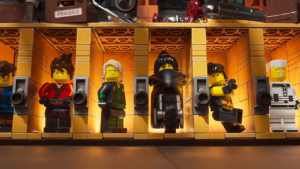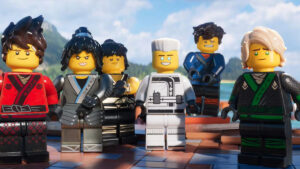The LEGO Ninjago Movie (2017) review
Dir. Charlie Bean, Paul Fisher, and Bob Logan
By: Steve Pulaski
Rating: ★★½
The LEGO Ninjago Movie represents the end of the honeymoon period that I, and many others, have had with the LEGO cinematic universe up until this point. The LEGO Movie stormed on the scene back in 2014, a bit tardy, but well worth the wait as it surprised and captivated audiences with its meticulously detailed animation style and zippy fun with strong social commentary. The LEGO Batman Movie followed suit earlier this year, drumming up the same kind of positive praise. It also showed the range the films had in conjunction with their toy counterparts, with the capability of being versatile and kinetic, as well as unique when it comes to telling superhero stories.
Now comes the film adaptation of LEGO’s successful toyline “Ninjago” (a portmanteau of “Ninja” and “LEGO,” which took me far longer to figure out than I care to admit), an internationally successful series of ninja and ninja-related characters and play-sets. Having no familiarity with Ninjago, being that it was introduced after my childhood, it appears similar to the Bionicle franchise, the once popular LEGO spinoff that presented a darker, more action-packed level of excitement than just conventional LEGO sets.

The problem with Ninjago as seen in film-form is that much of the action is overstylized and manic, with the franchise finally succumbing to the feat that even found ways to interfere with my enjoyment of the original. The film moves fast and squanders a lot of its memorable moments, beautiful set-design, and awe-inspiring animation simply because it can’t slow down for a few seconds.
The film revolves around a group known as “the Secret Ninja Force,” an elite squad of six ninjas with special powers they utilize in order to beat Lord Garmadon (voiced by Justin Theroux), the evil Dark Ninja. One of the ninjas – the Green Ninja, to be precise – is Lloyd Garmadon (Dave Franco), the Dark Ninja’s estranged son, who works with his pals (voiced by everyone from Michael Peña to Kumail Nanjiani), all of whom trained by Master Wu (Jackie Chan), the eccentric leader.
When Lloyd reveals to his father that he, the Green Ninja, is actually his sixteen-year-old son, this ignites daddy issues like no other. The relentlessly evil Lord Garmadon begins to backpedal on his plan to take over the community of Ninjago by bonding with his son, despite signaling to everyone that he doesn’t want to be a part of the scrappy young kid’s life. Meanwhile, Master Wu’s fate is a message of urgency to the group of ninjas, whose special powers range from the use of ice, water, and fire, to work in unity to defeat the common enemy – even if the enemy, in this case, is a four-armed relative of one of the ninjas.
The most jarring difference in The LEGO Ninjago Movie, when compared to the two previous films, is its editing and composition. Woven together like a strangely edited martial arts movie, the film makes use of cartoon serials, random archival footage, and bizarre interjections that are supposed to give it the look and feel of something far more nostalgic. I could say that it’s a complete distraction, but given the energetic composure of The LEGO Batman Movie, it’s not worlds different.

The problem is that the film’s manic sensibilities have finally caught up with it, and as a result, The LEGO Ninjago Movie feels redundant and too similar to its predecessors in terms of characters. Lloyd (or “La-Loyd,” as he’s called by his father, putting emphasis on the first of two “L’s”) is essentially the same character as the LEGO everyman Emmett from The LEGO Movie, and his commonality as such shows even if Franco’s voice-acting is a bit above average in conviction. Couple the similar characters with the lengthy displays of action sequence that lopsidedly hinder a 95 minute movie and there’s a recipe for repetition that shouldn’t be present in a movie featuring our favorite construction toys coming to life.
That’s not to say there isn’t success for the LEGO movie franchise going forward, nor that the inevitable sequel to The LEGO Ninjago Movie will be an average or slightly below-average outing like its debut. This shows that the universe is at a crossroads at the moment with an uncertainty of how to pursue onward. I’ve long suggested a give-and-take route, where the energy emboldened in these films can still be in place while giving way to more grace in pacing. I also opine more appreciation for the painstakingly rendered playgrounds on which the characters interact, for so much artistry is behind those that is lost in a lot of rambunctious comedy and silly Easter eggs.
Speaking of which, the grace period for this franchise is over with The LEGO Ninjago Movie, no matter how happy the inclusion of a Jim Croce song made me or how nice it was to hear a different cast of voice-actors. Going forward with a LEGO Batman sequel, a sequel to the film that kicked this whole thing off, and the ambiguously titled stand-alone film The Billion Brick Race, there must be a re-evaluation of direction and presentation or else these films will find themselves downgraded exponentially and back on the bargain-bin DVD racks where they once resided.
My review of The LEGO Movie
My review of The LEGO Batman Movie
My review of The LEGO Movie 2: The Second Part
My review of Piece by Piece (2024)
Voiced by: Dave Franco, Justin Theroux, Fred Armisen, Abbi Jacobson, Kumail Nanjiani, Michael Peña, Zach Woods, Olivia Munn, and Jackie Chan. Directed by: Chris Bean, Paul Fisher, and Bob Logan.
About Steve Pulaski
Steve Pulaski has been reviewing movies since 2009 for a barrage of different outlets. He graduated North Central College in 2018 and currently works as an on-air radio personality. He also hosts a weekly movie podcast called "Sleepless with Steve," dedicated to film and the film industry, on his YouTube channel. In addition to writing, he's a die-hard Chicago Bears fan and has two cats, appropriately named Siskel and Ebert!


